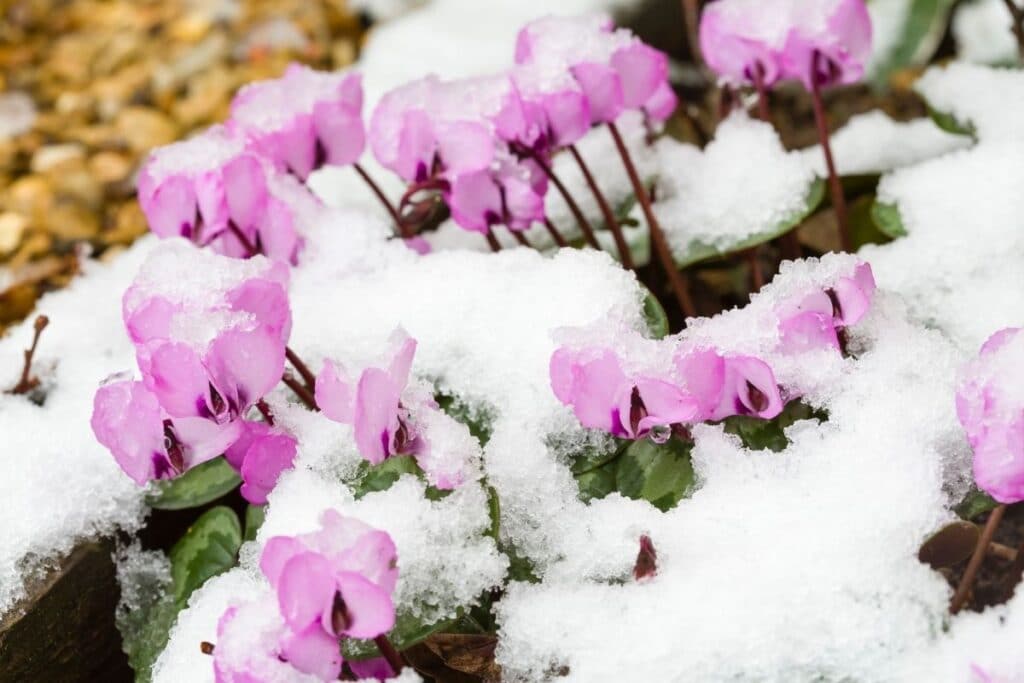Do you know which flowers that bloom in winter? To many people, the winter season brings forth a feeling of coziness as they curl up and enjoy the indoor warmth of hot cocoa and the fireplace. But winter is generally associated with freezing temperatures and long nights which may have their negative connotations. These are in fact, slower days and the extreme weather conditions render the outdoors dull and severe-looking.
- Aeonium ‘Voodoo’
- Algerian Iris
- Alpine Rockcress
- Bulbinella Nutans
- Bush Lily
- Christmas Cactus
- Cornelian Cherry
- Diotis Maritima
- Early Stachyurus
- Feather Reed Grass
- Flowering Kale
- Fragrant Daphne
- Fringetree
- Golden Wattle
- Gorse
- Grevillea ‘Winter Delight’
- Happy Wanderer
- Harlequin Glorybower
- Mahonia
- Honeywort
- Hop Trefoil
- Iceland Poppy
- Jade Plant
- Japanese Andromeda
- Japanese Quince
- Kalanchoe
- Lamb’s Ear
- Large Blue Hepatica
- Manzanita
- Mimosa
- Mignonette
- Mountain Pepper
- Nemesia Caerulea
- Opal Flower
- Orchid
- Orchid Cactus
- Orchid Tree
- Paperbush
- Pin-cushion Hakea
- Pink Heath
- Poinsettia
- Protea
- Purple Rock Cress
- Queen Anne’s Lace
- Red Maple
- Ribbon Bush
- Silktassel
- Silver Dollar Tree
- Soap Aloe
- Sweet Box
- Weeping Apricot
- Winter Cheer
- Winter-flowering Cherry
- Winter Hazel
- Winter Heath
- Winter Jasmine
- Wintersweet
- Wurmbea Stricta
- Viburnum Fragrans
- Violets
- FAQs
Wildlife often goes hibernating to keep themselves from the exhausting cold days while the immobile plants are left in the open, vulnerable to the destructive tendencies of winter.
To the artists and gardeners, the white and gray winter serves as a blank canvas, calling for the colors and details plants could have provided naturally but winter can be brutal.
However, some plants are quite persistent. It is as if they do not care if the freezing weather destroys them as long as they are able to put on a show and bring life to the cold days ahead. The amazing things plants can do!
This only shows that gardens can still stand out and provide colorful blooms while braving the blankets of snow. With proper garden planning, plants will surprise you with amazing blossoms and to get you started, here is a list of the favorite winter flowers of gardeners. Some of these flowers can be used for weddings too.
Aeonium ‘Voodoo’
Aeonium is a succulent plant that has pointed fleshy leaves forming a rosette often on ends of long branches. The variety ‘Voodoo’ is grown in the garden for its peculiar foliage that is dark burgundy, almost black.
In winter, this succulent produces a showy cluster of golden star-like flowers and pointed flower buds in the middle of the rosette (1).
Most aeoniums are monocarpic so after the spectacular show, the plants will eventually die. Aeoniums are tough plants, able to adapt to almost all kinds of environments.
Since their fleshy leaves store most of the moisture of the plant, they don’t have the most established root system. When potted, they will need a lot of garden soil.
Algerian Iris
An evergreen herbaceous plant, Algerian iris or Iris unguicularis endures the winter and even produces eye-catching lilac flowers throughout the season. The fragrant delicate light purple petals with yellow and white striations are emphasized against the dark green grassy foliage and aside from being a wonderful garden beds and borders, the long-lasting blooms are used as cut flowers too (2).
There are many varieties of Algerian iris for more interesting winter bloom. ‘Walter Butt’ has bigger wispy flowers, ‘Mary Barnard’ is more of a royal purple, and white ‘Alba’ blends with the snow.
Alpine Rockcress
Arabis alpina or alpine rock cress is a species that bloom in winter. Its use in winter landscapes is often described as minimalistic because of the simple white flowers blooming on top of a slender stalk and small leaves.
In the wild, alpine rock cresses spread along riverbanks and damp gravel. Aside from moist soils, this plant does not need a lot to thrive.
It can grow in full sun or shade and fertile or acidic soil. However, wet conditions often entail pathogens so the plant is subject to rusts and mildews. Since it is a hermaphrodite, alpine rock cress fertilizes without the help of pollinators although bees and butterflies still love its flowers (2).
Bulbinella Nutans

Despite what the name might suggest, Bulbinella actually grows from rhizomes. It is a member of the aloe family and the species B.nutans is often seen growing in wet peaty soils. During winter, golden torch-like flowers bloom in between grayish grassy leaves which look impressive en masse.
Bulbinellas are not popular garden plants but they are fairly easy to grow and if given the chance, they will make delightful seasonal hedges (3). They can maximize the vertical space of the garden so it would be ideal to pair them with low-growing shrubs or herbs line jonquils, clematis, and daphnes.
Bush Lily
Clivias grow clumps of sword-like dark green leaves up to half a meter high making them commonly known as a bush lilies. In the middle of the clumps of one particular species, C. gardenii, spring long soft stalks that hold clusters of droopy tubular orange flowers with yellow stamens peeking out of the green tips (2).
Bush lilies grow in forests under the shade of tree canopies. In the 1800s, they began to be cultivated as specimen plants for gardens by the Duchess of Northumberland, Lady Charlotte Clive, to whom the plant was scientifically named after. Today, varieties of bush lilies come in yellow, pink, and red and are longer lasting.
Christmas Cactus
Schlumbergera truncata or Christmas cactus is epiphytic and makes a good indoor plant. Unlike most cacti which thrive best under direct sunlight and drought, Christmas cactus originated from rainforests so it requires indirect light and more water. Their preference for organic potting mix in containers allows them to live indoors (4).
Christmas cactus produces an amazing bloom albeit sporadic. The flowers borne at the end of the leaves have layered pink petals that look like scales. They instantly create a tropical vibe indoors during the bland, chilly winter season.
Many Christmas cactus owners cannot make the plant bloom so it is helpful to know that the plant needs shorter exposure to light in order to flower.
Cornelian Cherry
Cornus mas or cornelian cherry is a deciduous small tree known for its outstanding golden flowers that clothe the bare rich brown branches in late winter. In summer, the tree is covered in dense lance-shaped green leaves and clusters of bright red cherry-like fruits which are edible (5).
Cornelian cherry’s deciduous habit adds interest to the garden. It can serve as a specimen tree alone or as a seasonal screen and hedge en masse. It will perform best under full sun and any kind of soil. It attracts wildlife too so better expect visits from birds and small mammals to your garden.
Diotis Maritima
A unique member of the aster family, Diotis maritima or Achillea maritima could look just like any skinny aster plants except the whole plant is covered in dense woolly silver hairs.
At the end of each upright stems are tiny short-tufted bright yellow flowers. Diotis definitely stands out among the dark green plants of the late fall to early winter (3).
Diotis is originated from the shores of Medditeranean. It is salt-tolerant and love the sandy beaches. There are only a few gardens able to provide the requirements of this plant. In the UK, diotis plants are only found in a few sandy locations in Ireland.
Early Stachyurus
Early stachyurus or stachyurus praecox is a recipient of Award of Garden Merit and is probably one of the most beautiful flowers of winter.
After the tree loses it leaves at the start of the season, strings of tiny round yellow-green florets hang in rows by the end of the bare spindly branches. This floral display is mesmerizing to look at as the flowers dance with the cool winter breeze.
Early stachyurus is easy to grow. It may require rich, well-drained soil and full sun but once established, the plant will survive with little maintenance. It grows airy and wide so unless the garden has room to accommodate the spread, pruning as soon as spring arrives is required (5).
Feather Reed Grass
One of the highly preferred ornamental grasses, Calamagrostis x acutiflora or feather reed grass creates a colorful vertical effect, especially in masses. The thin strappy green leaves are always upright. In winter, the flowers cover almost half the height of the plant, creating a golden background (3).
Aside from the lasting colors they bring, feather reed grass behaves very well. It grows in clumps which ensures that they will not post a threat to other garden plants and become invasive. After blooming, the plant still looks tidy and the seeds produced are sterile, therefore no unwanted growth will occur. Reward them by planting in slightly wet soils and under full sun.
Flowering Kale
Flowering kale plants thrive in the cool days of winter and bring color to the otherwise gray garden. They are herbaceous annuals that form large mounded rosettes on the ground. The outer ruffled green leaves are usually heavy-veined and the younger leaves in the center are purple, sometimes white or pink (3).
They make fun borders, walking along paths lined with flowering kale makes one feel like they are surrounded with giant roses. They can also be grown en masse or in containers to make garden statement pieces. If adoring them makes you hungry, they can be eaten in salads just like regular kale.
Fragrant Daphne
This attractive plant thrives in warmer climates. The tubular pink or white blossoms of the daphne shrub appear in late winter or very early spring and have a delightful sweet, fruity perfume. The evergreen shrubs have many uses in the garden such as hedge, foundation, border, etc… (6).
Fragrant daphnes are quite difficult to establish. They prefer cool well-drained soil and are easily affected by virus diseases. They are slow-growers too but can eventually reach more than a meter high. All parts of the plant are poisonous so better grow them away from children’s reach.
Fringetree
Chionanthus virginicus is commonly called fringetree because of the wonderful winter clusters of drooping long-petalled creamy flowers. These flowers cover the tree like cottons for weeks and the effect is best appreciated when the tree is set against dark evergreen plants (7).
Fringetree is well adapted to urban conditions, it establishes well after being transplanted. The leaves look healthier under partial shade and the flowers are more stunning under full sun. It is usually trained as a small tree, maintaining a 3-5 meter height but in the wild, it can grow as high as 10 meters.
Golden Wattle
Golden wattle or acacia pycnantha is a leguminous tree celebrated for its profuse bright yellow winter bloom. The beautiful flower is a national emblem of Australia.
The plant is tolerant of almost all kinds of environment and grows naturally in forests and grasslands. A single tree makes a good specimen and mass planting creates strong borders.
Golden wattle fruits and flowers are edible and are eaten by the indigenous people of Australia. Fruit extracts are also used as medicine and sap from the bark makes a good adhesive. The plant is generally useful to people and butterflies which feed on the fragrant flowers too.
Gorse
Ulex europeaus or gorse produces one of the most charming flowers of winter. The pea-like yellow flowers blanket the sprawling branches filled with thorn-like leaves (8).
They have a unique fragrance described as vanilla-like with undertones of orange and pineapple. Overall, the plant has a dense growth which is preferred as nesting areas of birds.
Gorse plants are native to Europe. They are easy to grow, thriving best in poor soil and sunny locations. They make effective windbreak hedge, creating a strong barrier with its pointy thorns. The plant is also valuable in the textile industry as the flower is a source of a beautiful shade of yellow dye.
Grevillea ‘Winter Delight’
Grevilleas are remarkable compact low-growing shrubs that bear show flowers and attractive foliage. The leaves are either fern-like or needle-like. The hybrid ‘Winter Delight’ has soft gray foliage that serves as the perfect background to the clusters of red and cream flowers. These flowers are abundant when the plant is subjected to full sun and friable soil (2).
Grevilleas look stunning when mass planted along poolsides or in containers. Other varieties add dimension and interest to the garden such as ‘Ned Kelly’ with conifers like pinkish-yellow flowers, ‘Tuckers Dwarf’ with dark pink blossoms, and ‘pink pixie’ with whimsical light pink flowers.
Happy Wanderer
A playful climbing shrub, happy wanderer lives up to its name. It grows in almost all kinds of soil and sun conditions but of course blooms best with lots of sunlight.
The plant serves lots of roles in the garden, from mass planting to mixed bed to fence cover to trellis climbers. The purple and white flowers never fail to amaze garden visitors.
Indigenous many regions of South Australia, happy wanderer or Hardenbergia violacea is a precious plant species. It has a symbiotic relationship with root nodule-forming bacteria that fixes nitrogen in the atmosphere.
This fixation benefits not just the plant itself but the surrounding flora as well. The leaves and roots are edible too and they make a refreshingly sweet drink.
Harlequin Glorybower
Clerodendrum trichotomum is a shrub, sometimes tree, native to China and Japan. It forms a deciduous thicket of ovate dark-green leaves. And as the days approach winter, clusters of tubular white flowers appear all over the plant (3).
In winter, these tiny flowers transform into red star-shape with a round bright blue fruit in the center. The appearance looks like the comical harlequin that the plant is commonly called harlequin glorybower. Another common name is the peanut butter tree because of the flower scent reminiscent of our favorite snack spread.
Mahonia
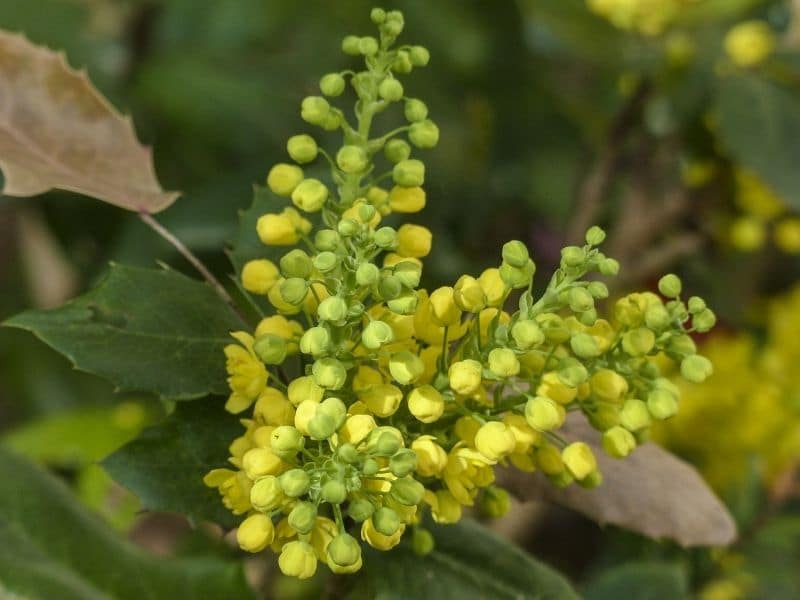
A member of the barberry family, Mahonia spices such as Mahonia aquifolium and Mahonia japonica have leathery, sharp-toothed leaves that remain green all year round. But what makes Mahonia stand out are the loose tentacle-like flowers that shine a bright yellow in winter.
The flowers grow dense that they are hard to miss at a distance as well as their sweet fragrance. The blossoms eventually transform into grape-looking waxy fruits, hence the common name.
Mahonia flowers actually bloom in late spring but a practice of pruning some of the stems bearing the flower buds forces the plant to flower earlier. They make awesome garden borders and foundation plantings, especially when they start their floral show (5).
Honeywort
Cerinthe major is a species of honeywort often found in meadows and grasslands. The name is Greek for wax flower owing to a story that bees obtain their beehive wax from the flower.
The ‘Purpurascens’ variety is characterized by soft stems encircled with small fan-shaped grey-green leaves. The terminal leaves turn bluish or purplish in color and appear overlapping as if protecting the bell-shaped rich purple flowers.
After blooming from late winter to early spring, honeyworts produce large black seeds carried by wind or birds to germinate. Before the next season starts, the early spring blooms deteriorate which will be replaced by new plants that sprout from germinating seeds (3).
Hop Trefoil
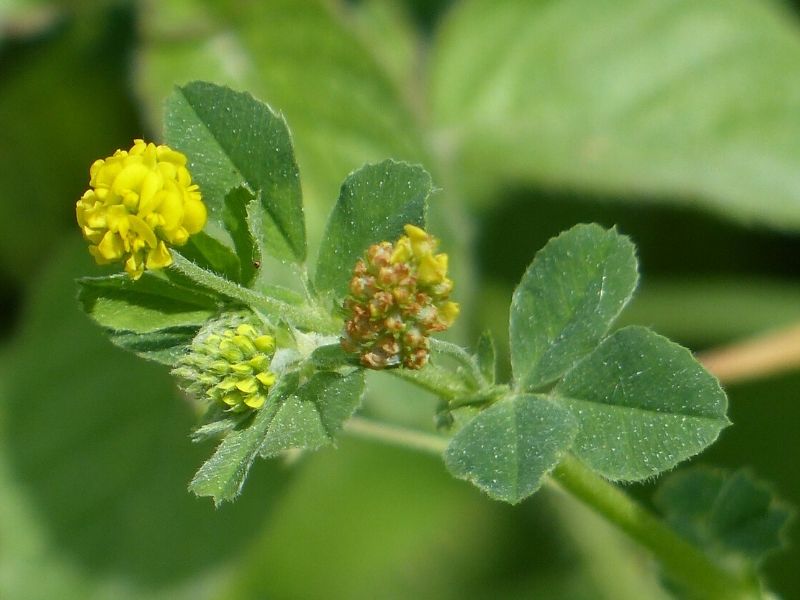
Hop trefoil or trifolium campestre is a wildflower that lives in dry grassy areas. It started to be grown as an ornamental plant because of the lovely coarse globe-like bright yellow flowers usually seen at the start of winter (8).
It also bears dainty three-lobed leaves from which the name was derived. As masses of hop trefoil spreads through the garden, they create a compact groundcover. They are annuals so they need to be reseeded in summer for an early winter bloom.
Despite the weedy growth habit, the plant is not considered a threat because like many leguminous plants, it contributes nitrogen to the soil. And it also provides nutritious feeds to livestock.
Iceland Poppy

Fields of poppies always bring a warm cheerful feeling and seeing them grow and bloom at the onset of the chilly winter makes the season more bearable. Papaver nudicaule or Iceland poppy is hardy and can endure the cold months while creating a brightly-colored haven.
Iceland poppies do not need a lot of tending. They grow freely under the winter sun and only requires watering when the soil becomes too dry. The plants spread in rich soil but flowering is discouraged. The colorful blooms are actually more profuse in areas where the soil is poor (9).
Jade Plant
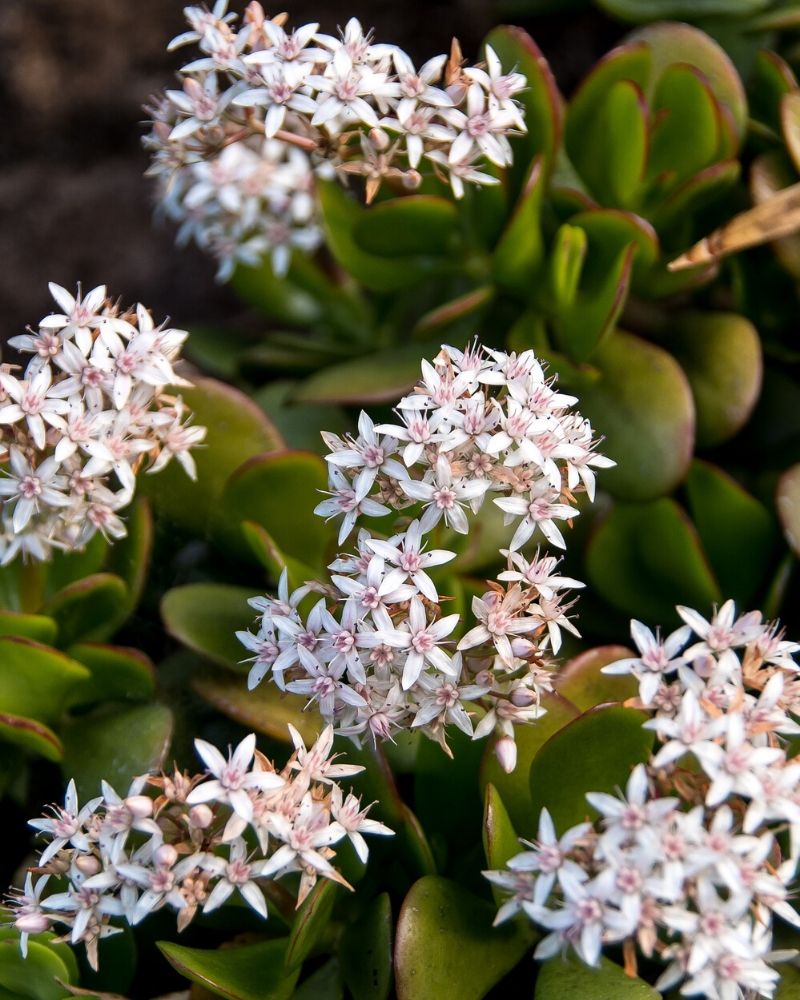
No one can go wrong in choosing a jade plant (Crassula ovata) as a house plant. It is a succulent that stores water in its thick leaves so watering is only required when the soil feels dry to the touch. It also likes plenty of sunlight and when the right conditions are met, jade plants will reward with beautiful bunches of tiny white or pink flowers (10).
Jade plants are considered lucky by the Chinese. Planting them in porcelain containers indoors is said to bring good financial luck. These winter bloomers are also edible, some African tribes feed on the roots and leaves and sometimes use them in treating mild illnesses too.
Japanese Andromeda
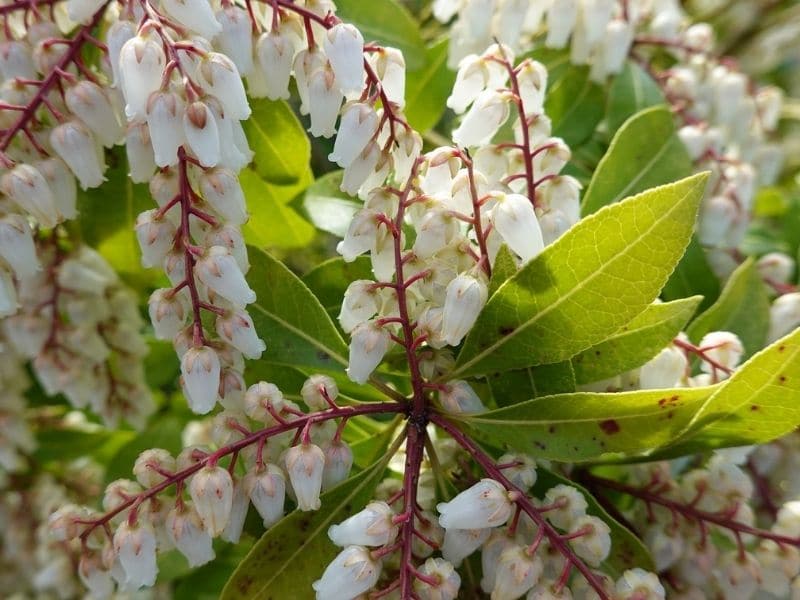
Pieris japonica, also known as Dwarf Lilly-of-the-Valley Shrub, Japanese pieris, or Japanese andromeda is a real head-turner. The evergreen plant has spear-shaped leaves that are color-changing, bringing life to the snowy winter.
In the middle of the season, long clusters of white bell flowers dangle at the end of the green stems. This floral display brings a dramatic effect to the garden that they are often grown as specimen plants (3).
Other varieties of Japanese andromeda bring new beauties to the table. ‘Pygmaea’ is an excellent choice if you want a small but compact growth, ‘Variegated’ has attractive white striations on the leaves, ‘Mountain Fire’ adds bright red-orange spring blooms; and ‘Valley Valentine’ showcases pink flowers and red floral buds.
Japanese Quince
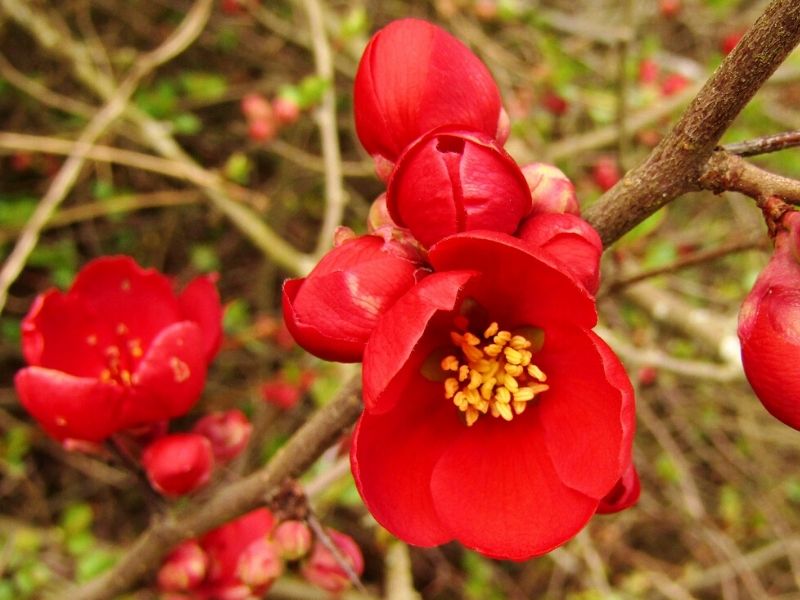
Introduced from Japan, Maule’s quince or Chaenomeles japonica makes the winter season more interesting by filling its spindly dark brown branches with marvellous bright red blooms.
A very attractive shrub, it is often used to line fences and walkways or trained on trellises. In Japan, the Japanese quince is a favorite bonsai plant (11).
The beauty of Japanese quince is not immune to pests and diseases. The plant is prone to fungal leaf spot and aphid attacks and immediate application of treatment must be performed, otherwise, the blooming will be highly affected and the plant can die.
Kalanchoe
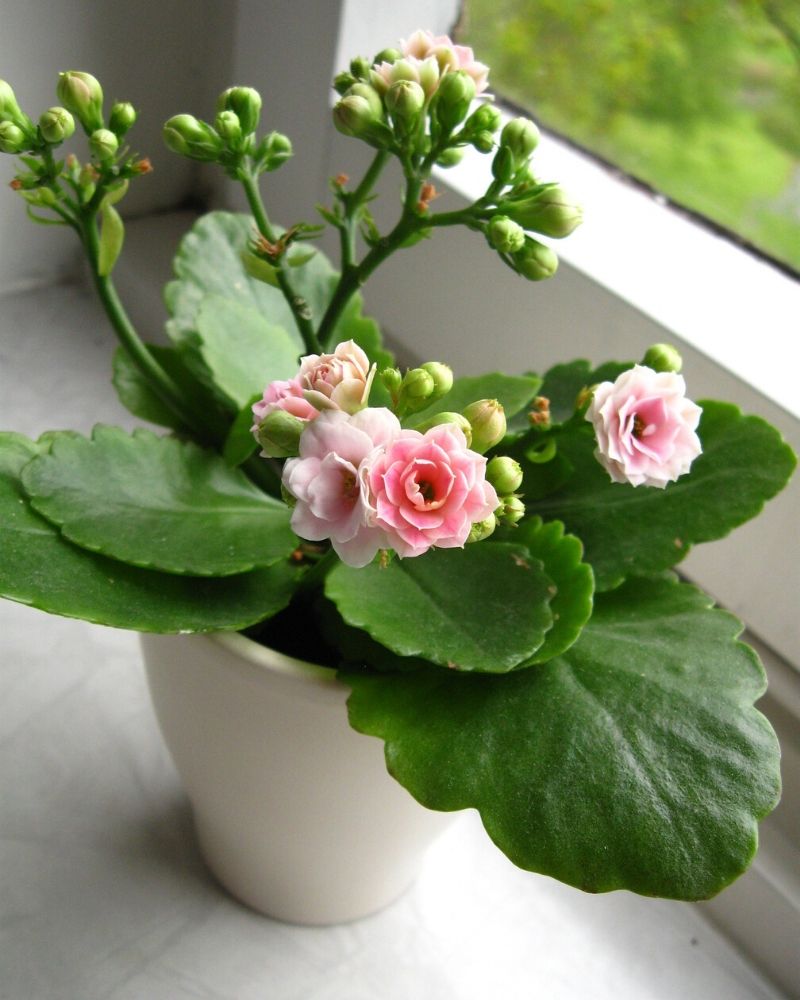
Another succulent plant that can thrive indoors, the foolproof beauty of Kalanchoe (also called widow’s-thrill or kal-un-KOH-ee) has made them popular. Kalanchoes have thick broad leaves that allow them to harness as much sunlight as they can even if grown in shaded areas.
Come winter, instant bouquets of stunning flowers in orange, yellow, pink, purple, and white appear in the middle of the basal leaves.
Aside from being excellent indoor plants, kalanchoes can also be seen as bedding and border plants often with other plants in softer shades. They are very easy to propagate. Stems and leaves can be cut and directly planted into pots. There are varieties that produce plantlets that have developed roots too (10).
Lamb’s Ear
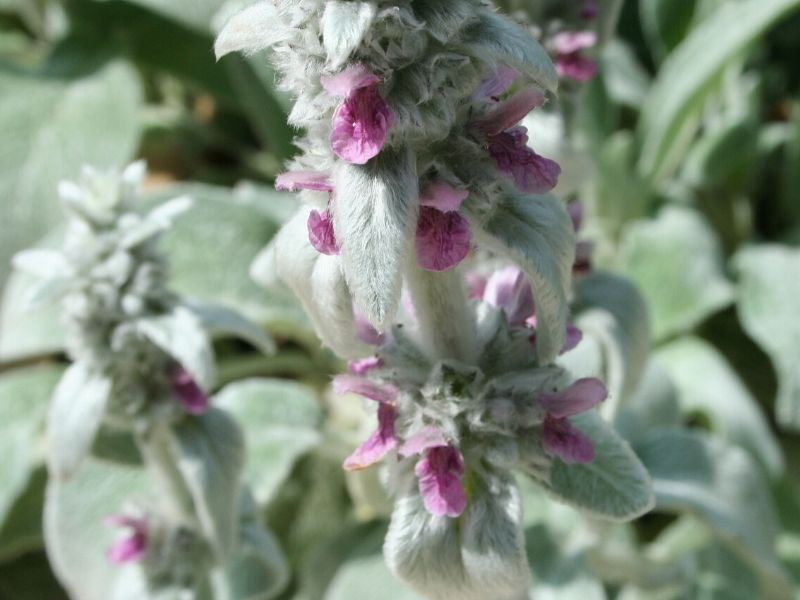
There are select plants that are grown for their ornamental leaves and one of them is Stachys lanata or lamb’s ear. It has one of the most appealing and fragrant foliage with lance-like leaves covered in silvery trichomes that feel like fur when touched. It is a hardy plant that stand-out from the dark green-leaved or bare plants of winter (3).
However, it’s not just the leaves that make lamb’s ear a valuable plant. It produces tall upright racemes of purple flowers looking majestic both near and from afar. For a fuzzy-looking flower stalk, ‘Cotton Boll’ is an excellent option.
‘Big Ears’, as the name suggests has bid leaves which look more irresistible to touch. ‘Silver Carpet’ is short and flowers less making it suitable as a groundcover.
Large Blue Hepatica

Hepatica transsilvanica is a member of the buttercup family. Commonly known as large blue hepatica, it bears beautiful blue flowers with overlapping petals and tufted center.
The flowers appear on the bare forest floors while the snow gradually melts. They look amazing together with the colorful jonquils and clematises (9).
The scientific name of the plant refers to the liver-shaped leaves and Transilvania, where it originated. There is a belief that since hepatica leaves look like the liver, they will make good remedies for any disease related to that organ.
Manzanita
Scientifically called Arctostaphylos, manzanita refers to the genus of over 40 species native to the Western United States. The tree has been popularized for it is one of the unique plants that have shiny red bark.
In late winter appear long-lasting urn-shaped flowers in bright and light shades of pink, purple, and white (2).
Manzanitas are drought tolerant and look the greenest during hot summer days. They do not like to be watered frequently and ironically, tend to suffer from irrigation and fertilizer application. As long as these conditions are taken into consideration, manzanitas will thrive and may even live up to a hundred years.
Mimosa

Acacia dealbata commonly mimosa, may be one of the most extravagant flowers that bloom in late winter. The tree shines like the sun with the blooming of compound clusters of golden-yellow flowers. The beautiful feather-like bluish-green leaves definitely complement this floral display (2).
Mimosas grow naturally in woodlands, wet forests, and along riverbanks where they form dense thickets. In urban areas, they are used as street trees for the attractive foliage and flowers.
They establish quite fast but the branches are weak and easy to break. They should be planted with tall shrubs or small trees that will serve as a buffer during windy days.
Mignonette
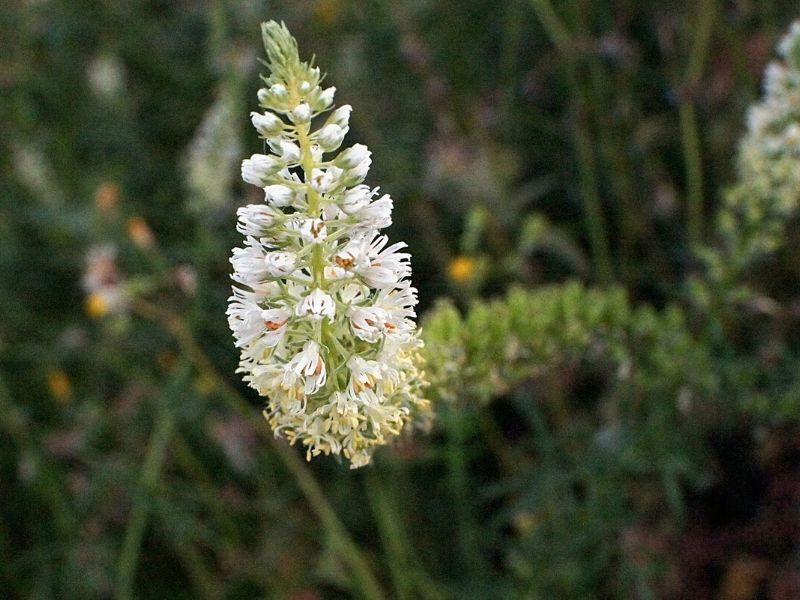
Mignonette is a simple perennial plant growing as a wildflower in woodlands. The creamy-white flowers are borne on the upper part of long thick stems. Masses of this plant emit a strong spicy-sweet fragrance that has been associated with the winter season. Even dried cut flowers retain their scent.
This plant is hermaphrodite and is capable of self-seeding. Because of this, it can form dense clumps and sometimes invade other plants in the winter landscape.
In fact, they are considered weeds in many specialized gardens. Deadheading or the removal of dried flowers is recommended to prevent germination and avoid random unwanted growth of the plant (3).
Mountain Pepper
The red stem and the dense foliage that stays green from season to season are some of the defining characteristics of Drimys lanceolata or mountain pepper (also known as Tasmannia lanceolata and Tasmanian pepperberry).
Native to the rainforests of Australia, the plant was introduced for ornamental usage because of attractive leaves, stems, and flowers. Creamy white or pale yellow flowers appear more attractive against the glossy green leaves (2).
After the flowering period in winter, mountain pepper develops clusters of black berries which when dried, can replace the culinary household pepper. In the landscape, a series of mountain peppers are densely planted so serve as exceptional barriers which can be aromatic when in bloom.
Nemesia Caerulea
Nemesia caerulea covering the garden floor is always mesmerizing to look at. It is a small herbaceous plant that has upright stems and spreading growth. In winter days without frost, the cold-loving beautiful lobe-petalled flowers in purple, blue, pink, and white almost entirely replace the green foliage.
Nemesias prefer fertile, well-drained soils and lots of sunlight. They will need frequent watering during the growing season but once established, they don’t need much attention. There will be flowering seasons that will exhaust the blooms but they will profusely bloom again when cut back.
Opal Flower
They say most winter flowers are yellow because insect pollinators seek the sunny color in the midst of snow that they developed a tendency to favor the yellow or golden colored plants.
Among these are the Lachenalia aloides or opal flowers. Sprouting in the middle of glossy strap-like leaves, spikes of flowers are tubular, golden florets with tinges of red. They are like tiny bananas hanging from thin stalks (12).
The flowers are fleshy and last long in bouquets. In the garden, they will put a smile on the face of every passer-by, especially when paired with contrasting blooms like hyacinth flowers. They are perfect in rock gardens, window planters, and pots.
Orchid
Many orchids are expensive which may be justified by the glamorous appearance they bring to your bouquets or gardens. All orchid flowers that bloom in winter emanate elegance and the season can definitely work with a little class that is long-lasting too!
Many orchid species bear different flower forms and colors. Moth-like phalaenopsis is a classic, branching oncidiums are ruffled, and the dangling cymbidiums are dramatic (13). These orchids will definitely make gazing at your garden all winter-long worthwhile and they are almost always available at local nurseries too!
Orchid Cactus

Epiphyllums are aerial plants living in between rocks and on tree branches, absorbing moisture from the air through their aerial roots. They do not have leaves, just multi-functional stems that store water and produce chlorophyll to keep the plants alive. It is along the stem edges that flower buds form too (12).
The common name orchid cactus or disocactus ackermannii refers to the showy orchid-like flowers blooming in winter. Because of their sprawling growth, they are most attractive on hanging pots where the stems can dangle.
Orchid cacti can take care of themselves. You can go on for weeks without tending to them and they will still look magnificent. In areas experiencing frosty winter, orchid cacti must be brought indoors to avoid decay (4).
Orchid Tree
The orchid tree or Hong Kong orchid tree is not a true orchid but actually a relative of peas. The scientific name is Bauhinia blakeana and it produces pink to purple blossoms that look like orchids. These showy flowers are hard to miss as they can grab your attention even from afar (2).
Some varieties lose their foliage to make way for the winter bloom while others keep their butterfly-like leaves for a more interesting appeal.
Orchid trees easily adapt to the urban scene and are sometimes found lining the busy streets. The branches have a sprawling growth so seasonal pruning is required to keep them tidy. The cold hardy plant was initially discovered in Hong Kong where it is part of a rich culture and is the official floral emblem.
Paperbush
Edgeworthia chrysantha or paper bush is native to China where the bark is used to make paper, hence the common name. But aside from the industrial use, the plant is also known to brighten the winter season by covering the naked tree with hundreds of heads of fragrant yellow flowers.
In the summer, these flowers are replaced by elongated lanceolate dark green leaves with interesting white venations.
Paperbushes can be grown as garden accents or hedges. Their root system can also be trained to fit decorative containers which are then placed in the middle of gardens or by the entrance of houses (3).
Pin-cushion Hakea
Hakea laurina is a popular Australian winter bloomer. As the common name implies, the flower looks like a round red pincushion pierced all over by white needles.
The flower is definitely the star of the plant but the weeping leaves and stems are just as interesting. Upon closer inspection, the knife-like bluish-green leaves have unique venations and the lanky spindles of a stem are actually bright red!
If allowed, pincushion plants grow as high as 6 meters although their root system does not establish well so tree stakes or supports should be installed. They make good garden specimens or screen if grown a little smaller and they are home to wildlife such as birds, bees, and butterflies as well (2).
Pink Heath
Epacris impressa or pink heath truly impresses with its incredible clustered display of bright pink flowers blooming before and after winter. The epithet, however, refers to the impression or indents on the end of the tubular flowers. Many epacris species are found growing on top of hills.
On a normal day, common pink heaths small shrubs made of upright stems densely filled with sharp needle-like leaves. They can be propagated by seeds which can take about 2 months to 2 years to germinate! Or a faster and more successful way is by stem cuttings. Keep them in moist, friable soil under full sun and they will thrive.
Poinsettia
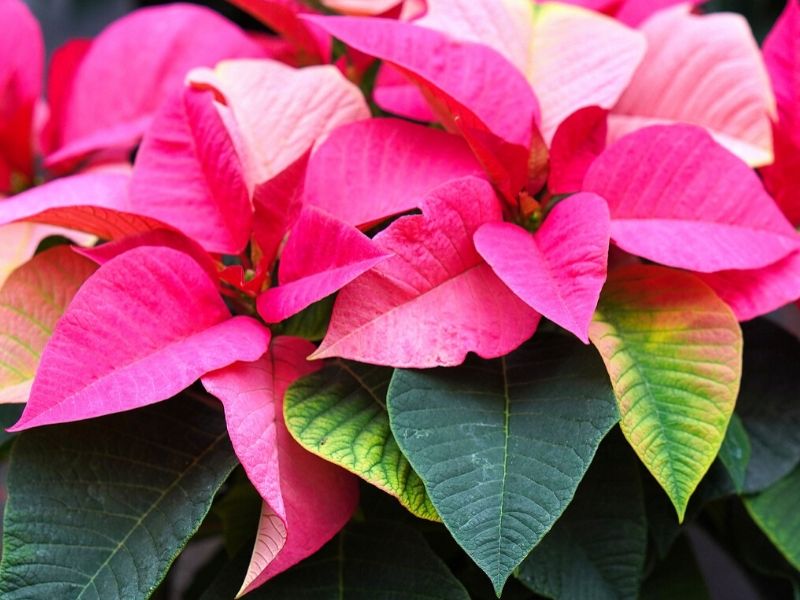
One of the best winter flowers, Euphorbia pulcherrima or simply poinsettia is always present in the interiors of both residential and commercial spaces.
They instantly create a Christmassy vibe with their attention-grabbing screaming red bracts mistaken as the flowers, although many varieties that exist today come in different shades of pink, yellow, and white.
Poinsettia plants are trained to look this way in time for Christmas. After flowering, the plant tends to outgrow its red color and the leaves turn to normal green. This may be attributed to the change in temperature and climate as the red in them likes cool longer nights (13).
Protea

One can never go wrong in choosing Protea flower (sugarbushes or fynbos) for a winter bloom. It only requires poor but well-drained soil and the plant will grow happily. Don’t fertilize them a lot and prune them after bloom to avoid pest and disease attacks.
Many species of protea are evergreen and live through the frost. In the middle of winter, you will fall in love with their flowers, even the closed ones (2).
The showy heads start out conifer-like and eventually opens, exposing colorful tufts and petals. Some of the amazing varieties are ‘Cream Mink’ with tips of the cream petals lined black, ‘Pink Ice’ which are hardy deep pink ones, and ‘Pink Stately’ with lovely pink petals with white edges.
Purple Rock Cress
Winter is the time purple rock cress blooms best. For most of the year, this aubrieta plant only have tiny round grayish-green leaves uneventfully covering the garden grounds, rocky areas or pots and containers.
Then come winter, it bursts into a majestic purple bloom! These flowers become more profuse on moist soil and in full sun (3).
Queen Anne’s Lace
Who knows that carrots can actually provide amazing winter flowers? Well, not the carrot that we know of but an ornamental one commonly known as Queen Anne’s lace or daucus carota and wild carrot.
The underground part of the plant is still edible, often used as a sweetener but the plant is generally planted in gardens for the elegant flowers that bloom in winter.
The umbrella-like clusters of flowers got its name from a legend which told that Queen Anne of early England pricked her finger and a drop of blood fell onto the lace cloth she was sewing. Aside from the delicate flowers, the plant is known for its fern-like leaves that make good garden groundcovers (3).
Red Maple
Everything about Acer rubrum is red, from the twigs, stems, and buds to the flower and leaves to the fruits. It does make sense why it is commonly called red maple and the white snow definitely provides the insipid background to this happy tree (3).
Red maples are generally great garden performers but if several conditions become extreme, they are not immune to pest and disease attacks. Common problems include tree cancer, leaf spot, and mildew. If symptoms and signs are observed, immediate treatment should be done.
Ribbon Bush
Purple flowers ignite neither warm nor cool feelings but they are surely an inviting sight in the midst of the blasé winter. And the purple that Hypoestes aristata brings is definitely worth the attention.
Ribbon bush in layman’s term, the plant bears airy clusters of purple flowers that look like fringed knotted ribbons. The petals are usually white with remarkable purple striations.
Only few gardens successfully house ribbon bushes. They do not perform well in containers or when disturbed hence many nurseries discontinued selling them. In South Africa where the plant originated, ribbon bushes are thriving and popular. Perhaps the plant truly prefers its origin soil.
Silktassel
It is always going to be a magical experience to stand under the Garrya elliptica tree and look up and gaze at the long tassels of beautiful white to yellow-green flowers.
During the frosty winter, the deciduous tree becomes covered in white snow and the catkin appear like extensions of melting snow that has frozen in mid-air.
To be able to witness this stunning flower display in your winter garden, make sure that the silktassel plant is at its best position. It likes to be protected from the cold winter breeze so definitely plant it in between evergreen tall shrubs or trees which will also provide a contrasting background to the whimsical blooms (14).
Silver Dollar Tree
Commonly known as the Argyle apple, mealy stringbark or Eucalyptus cinerea, the unique foliage of this plant makes it an interesting addition to the garden as a hedge or specimen.
The tidy arrangement of round silvery green leaves is very appealing to look at that aside from their role in the garden, they are used as fillers or the star in flower arrangement too (9).
In between the leaves of the silver dollar tree bloom flowers made of creamy stamen tufts arranged around a yellow center. They are very pretty to look at when in full bloom but aside from being pretty, the silver dollar tree can be medicinal too, able to treat cough, asthma, and even pneumonia.
Soap Aloe
A native to South Africa, soap aloe or aloe maculata is often used for its sanitizing properties. Extracts from the leaves serve as a substitute to soaps. It is also a known remedy for skin inflammation and endocrine system diseases. But as an ornamental plant, soap aloe has valuable foliage and flowers (9).
The fleshy leaves can be easily distinguished from the other aloes because they have prominent teeth. In non-frosty winter, showy flowers in spring in the middle of the rosette of leaves. The clusters of tubular orange flowers are a delightful sight especially when they are grown in compact masses.
Sweet Box
A member of the Buxaceae family, sweet box produces attractive foliage that endures the cold winter. The tear-shaped leaves are glossy dark-green, sometimes with white or yellow variegations.
At the point where the petioles touch the stem appear the fringe-petalled white flowers. These blossoms are small, almost unnoticeable from a distance but it’s their sweet scent that draws you in (14).
After blooming, black to bright red berries appear creating interest for the next season. This extraordinary year-round show earned the sweet box the Award of Garden Merit from the Royal Horticultural Society.
Weeping Apricot
The genus Prunus does not disappoint in terms of winter bloom. Prunus mume is a species originating from China and Korea that has been introduced and cultivated for its charming flowers.
In the middle of winter, when the plant has lost all its foliage, delicate fragrant pink or white or red flowers cover the exposed branches (11).
Blanketing the entire canopy with these flowers, the trees look like fancy cotton candies from a distance. No known disease disturbs the beauty of this plant but it is prone to insect pests like aphids, spider mites, scales, and caterpillars.
Winter Cheer
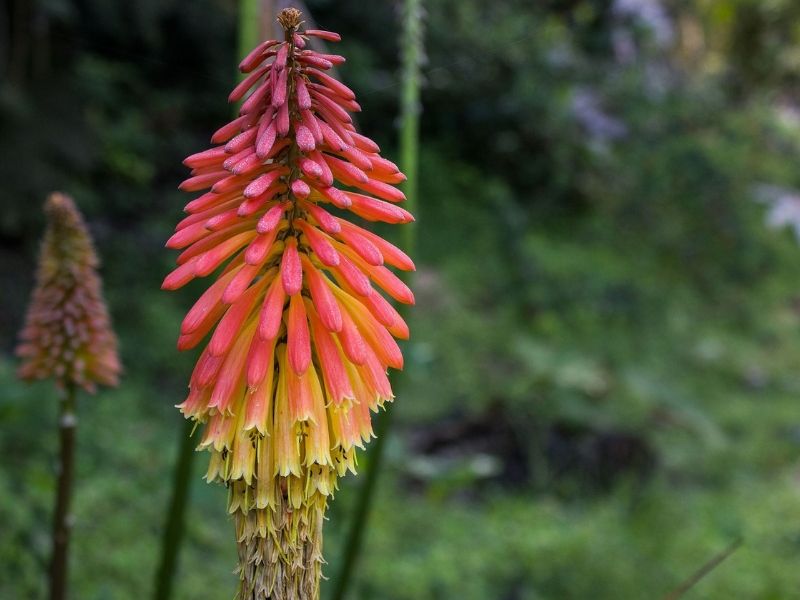
Kniphofia uvaria is exactly the cheer that winter needs. The pointy sword-shaped leaves set the mood to an exotic winter show. The flowers borne on long fleshy stalks look like fringed corn candies. The tubular flowers are neatly arranged around the upper end of the stalks. They form a color gradient from red to orange to yellow (2).
Winter cheer, like many members of the asphodel family, like a well-drained soil. It deteriorates when left in stagnant water starting from the roots. In an ideal environment, winter cheer will make a good specimen or perennial border if planted en masse.
Winter-flowering Cherry
Another cold blooming member of the genus Prunus, the winter-flowering cherry, also known as Higan cherry, spring cherry, or rosebud cherry, literally serves pale pink flowers on bare wooden stems.
The tree in full bloom is very remarkable, appreciated both near and far from the tree. Aside from the flowers, the rough barks are bronze and have a slight tinge of pink too.
Winter cherry is a versatile small tree, it likes full sun and any kind of soil as long as well-drained. It also rarely affected by pests and diseases (15).
Winter Hazel
Not to be confused with witch hazel, winter hazel or Corylopsis sinensis is a deciduous shrub that upon the arrival of winter, produces long pendulums of cup-shaped tiny yellow flowers on the bare branches. These flowers not only attract passers-by but hummingbirds as well (14).
Winter hazels are often planted as a hedge or specimen in gardens because they are good garden performers. As long as the roots have fully established and the plant receives filtered sunlight, winter hazel is all set, only needing water during high temperatures of summer. Mulches also help moderate the temperature of the soil.
Winter Heath
Colors aside from white, gray, green, and yellow are always welcome during the cold months of winter for a cheerful vibe, which is exactly what Erica carnea or winter heath brings. The pink to mauve flowers abundantly covering the small evergreen shrub is a feast to the eye (11).
Among the winter heath varieties to choose from are ‘Accent’ for the bright mauve flowers, ‘Anne Sparkles’ for its rose-pink flowers and orange-transforming foliage, ‘Aurea’ for the golden leaves and compact growth, and ‘Carnea’ for the light pink blossoms that darken into pinkish-purple.
Winter Jasmine
Flowering from November to March, the winter jasmine or jasminum nudiflorum is a proven survivor of the extremely cold season. The climbing growth habit allows the plant to better showcase its amazing flowers. The fragrant star-shaped yellow blossoms define the winter jasmine (5).
Like a vine, the plant is trained on a trellis. Passing through the canopy of sprawling stems peppered with these flowers is a one of a kind experience.
As a shrub, winter jasmines make effective border plants. Luckily, they don’t have any serious pests and diseases, although for best performance, plant them where there is enough sunlight, water only when the soil feels dry, and do not over-fertilize.
Wintersweet
Also a golden star of winter gardens, wintersweet or Japanese allspice or chimonanthus praecox surprises with its amazing bloom. During the more colorful days of the year, wintersweet is just little shrubs bearing unremarkable lance-shaped leaves. But as the days get colder and the nights longer, the plant branches turn bronze and loses its leaves and in their place appear paper-like star-shaped yellow blossoms.
These flowers are amazing to watch and when you come closer to the plant, the sweet fragrance will make you fall in love even more. Upon its introduction as an ornamental plant, wintersweet became an instant hit because of its modest beauty (14).
Wurmbea Stricta
Wurmbea stricta originated from the dry areas of Africa and Australia. It is often found growing near bogs and streambanks where it receives the moisture its roots needs and the sun its leaves and flowers require.
In the dry winter, wurmbeas produce a spectacular show of star-like white flowers with purple centers. The sweetly scented flowers are an amazing sight to see against the rather dull sub-Saharan (12).
There are other species with few variations that bloom in winter as well. W. inusta, W. hiemalis, W. marginata, W. monopetala and W. punctate are just some of the options. Most of these flowers only have flies as pollinators rendering them unpleasantly scented.
Viburnum Fragrans
Towards the end of winter, Viburnum fragrans or viburnum farreri releases airy heads of tiny trumpet-like pink flowers in lieu of the leaves that it decided to lose. The resulting shrub looks like a giant bouquet of dried pink and cream flowers. Originating from Europe and America, viburnums know how to handle the cold winter (14).
Viburnums are extremely tough plants, they can thrive with or without care but if you want a tidy appearance, the plant may need some pruning and fertilizer feeding, even if just once a year. If you want a practical addition to your garden, viburnum is definitely a no-brainer.
Violets
Probably the most popular winter bedding annual plant, Violas or violets definitely provides the color that winter is lacking. Violets actually come in different colors and are very hardy, able to endure the cold season while maintaining cheerful colors.
Fun fact: did you know that Violet is February birth flower?
They produce profuse blooms, almost covering the entire foliage of the plants and they thrive in almost all kinds of environment (13).
The best time to plant violas is in early-fall, while the weather conditions are still optimum for root establishment. Most gardeners know about this so nurseries always stock up in time for the winter bloom.
FAQs
What is the fastest growing plant in winter?
Winter Jasmine (Jasminum nudiflorum) is one of the fastest-growing plants during the winter season. This deciduous shrub produces bright yellow flowers on arching green stems and can exhibit vigorous growth even in colder temperatures.
Where is the best place for plants in the winter?
The best place for plants in winter depends on their cold tolerance and the specific climate. Generally, a sheltered location with good sunlight exposure and protection from harsh winds is ideal for many plants during the winter months.
Up next: 60 Flowers to Plant in the Garden for a Specular Summer Bloom
References
Reference List:
(1) Cort Sinnes, A. “Sunset house plants.” Lane Publishing Company. 1983. P. 112.
(2) Mathias, M. “Flowering plants in the landscape.” University of California Press. 1985. P. 215.
(3) Ferguson, N. “Right plant, right place: over 1400 plants for every situation in the garden.” Simon and Schuster. 2010. P. 368.
(4) Anderson, E. “The Cactus Family.” Timber Press. 2001. P. 776.
(5) Bales, S. “The garden in winter: plant for beauty and interest in the quiet season.” Rodale. 2007. P. 224.
(6) Lawrence, E. “Beautiful at all seasons: southern gardening and beyond.” Duke University Press. 2007. P. 238.
(7) Gilman, E. and Watson, D. “Plant Fact Sheet: Chionanthus virginicus.” University of Florida. 1993. P. 1-3.
(8) Harrap, S. “Harrap’s Wild Flowers.” Bloomsbury Publishing. 2014. P. 416.
(9) Holmes, R. “Taylor’s Master guide to gardening.” Houghton Mifflin Harcourt. 2001. P. 612.
(10) Baldwin, D. “Designing with succulents.” Timber Press. 2017. P. 304.
(11) Dirr, M. “Dirr’s Encyclopedia of Trees and Shrubs.” Timber Press. 2016. P. 952.
(12) Byng, J. “The flowering plants handbook..” Plant Gateway Ltd. 2014. P. 619.
(13) Vermeulen, N. “Encyclopedia of house plants.” Taylor and Francis. 1999. P. 320.
(14) Gossler, E. et. al. “The Gossler guide to the best hardy shrubs..” Timber Press. 2009. P. 204.
(15) Gilman, E. and Watson, D. “Plant Fact Sheet: Prunus subhirtella.” University of Florida. 1994. P. 1-3.
Close
*Featured photo by paulmaguire/depositphotos

